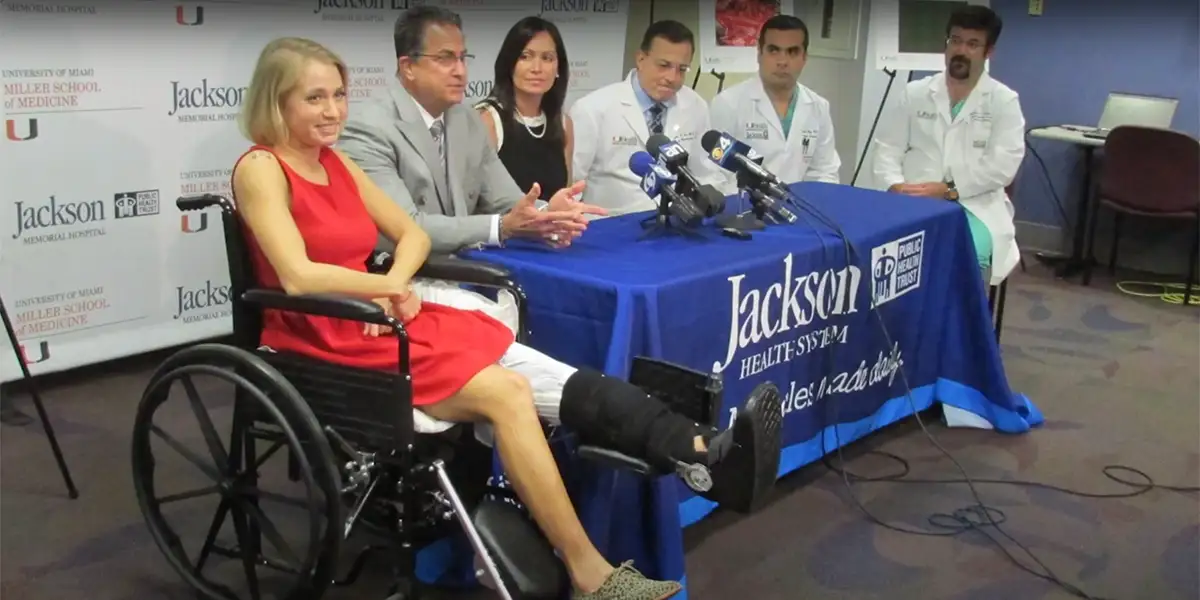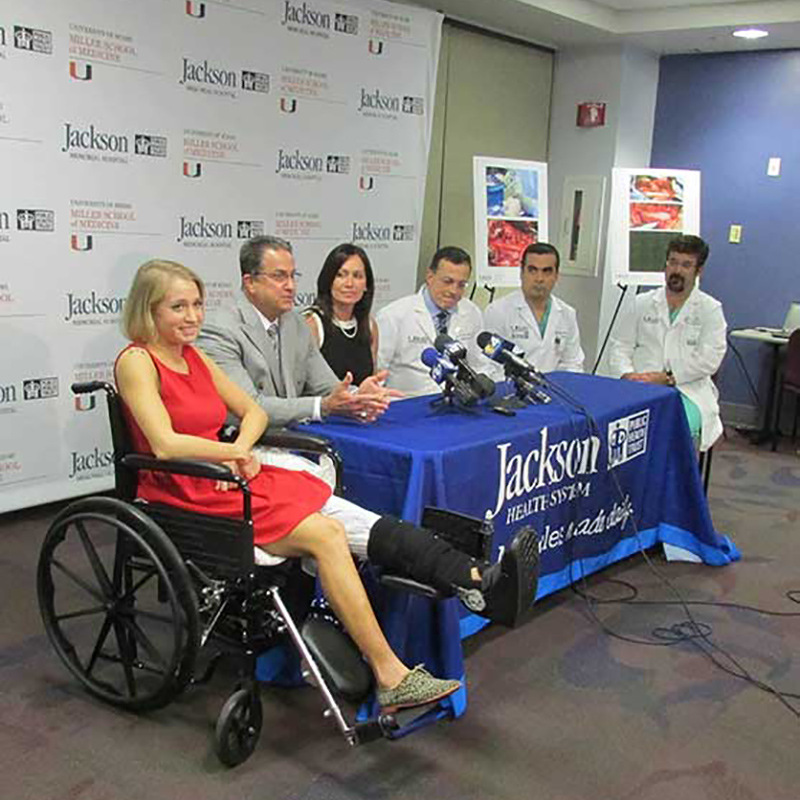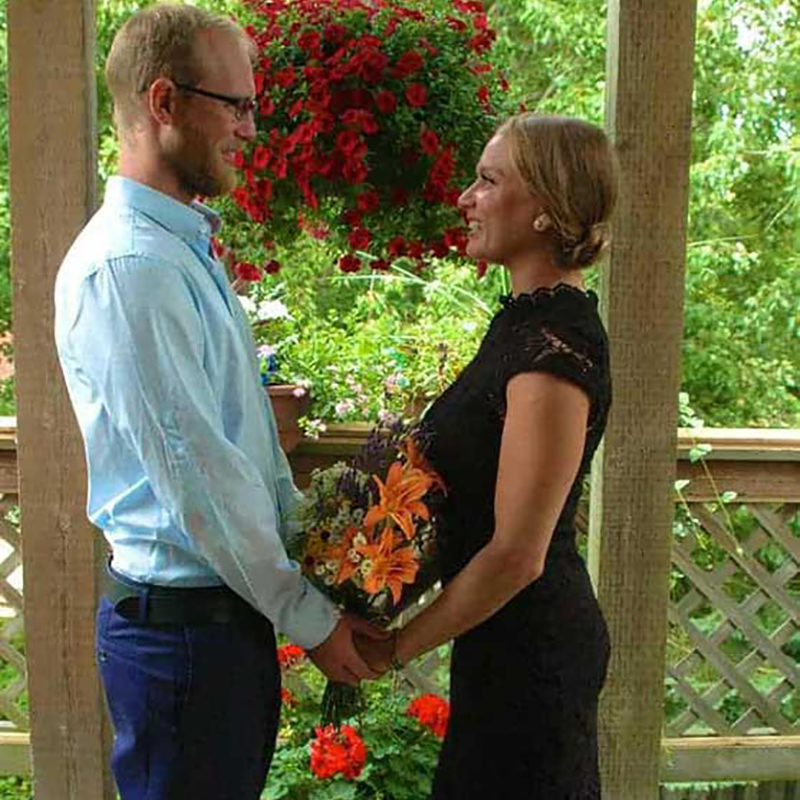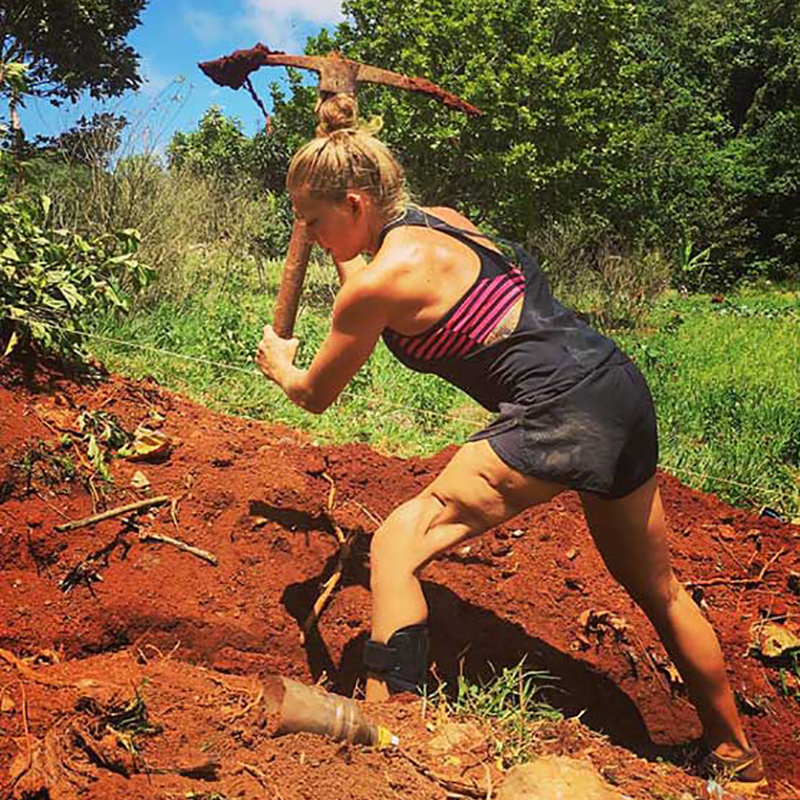Little Heart, Big Miracle: A Toddler’s Journey to Transplant after Awake ECMO Journey
Little Heart, Big Miracle: A Toddler’s Journey to Transplant after Awake ECMO Journey
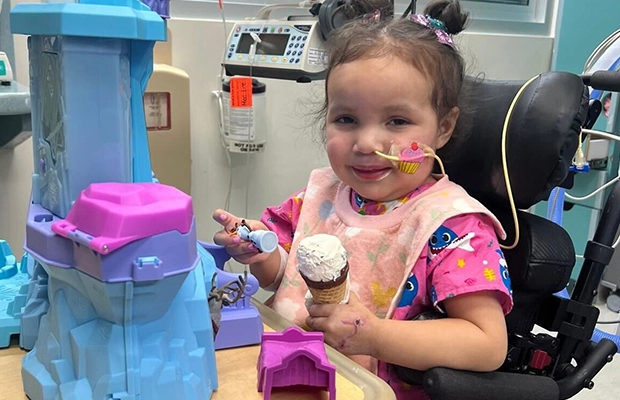
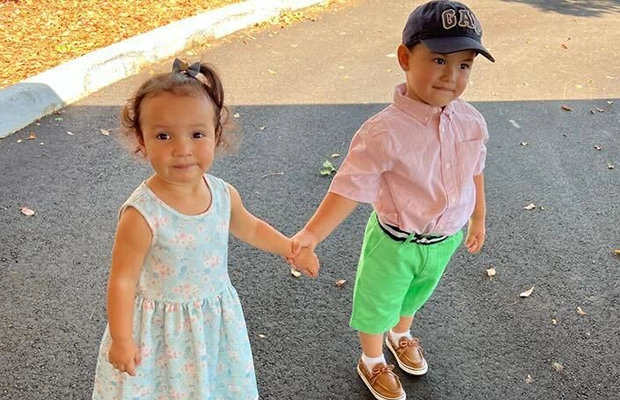
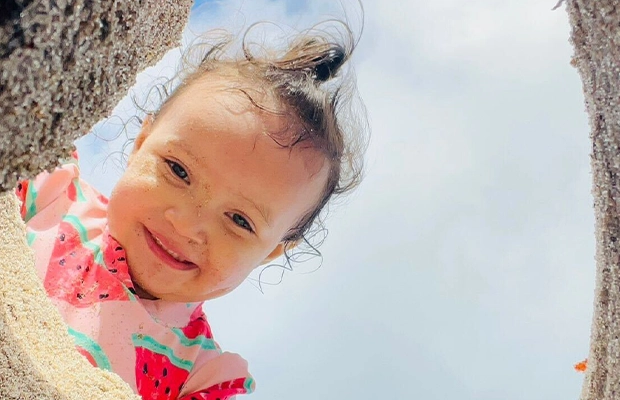
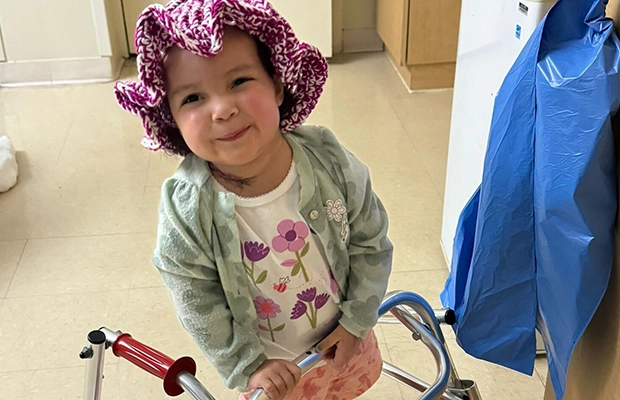
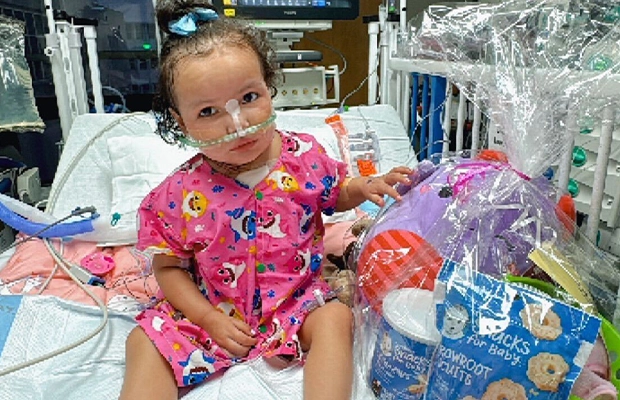
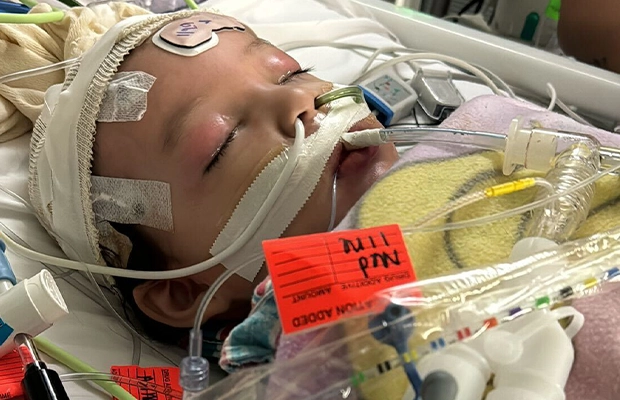
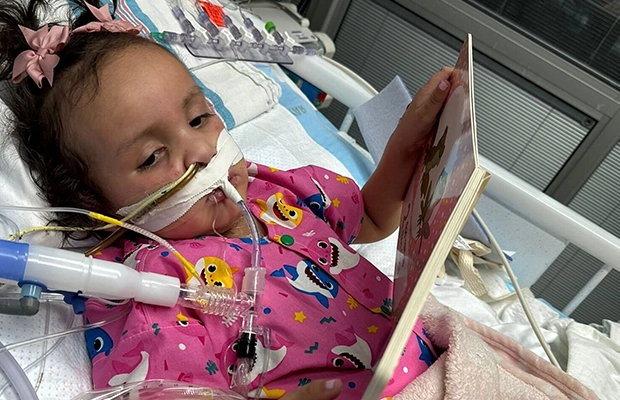
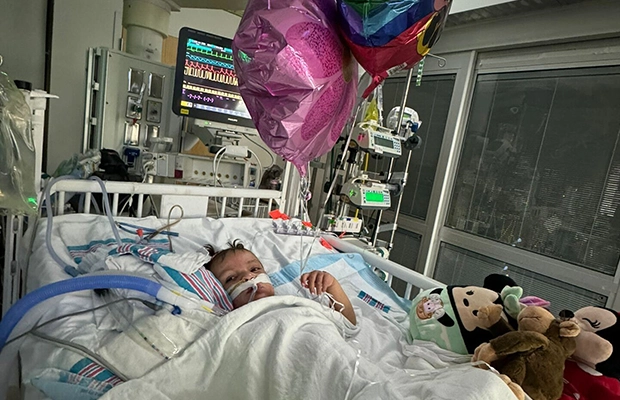
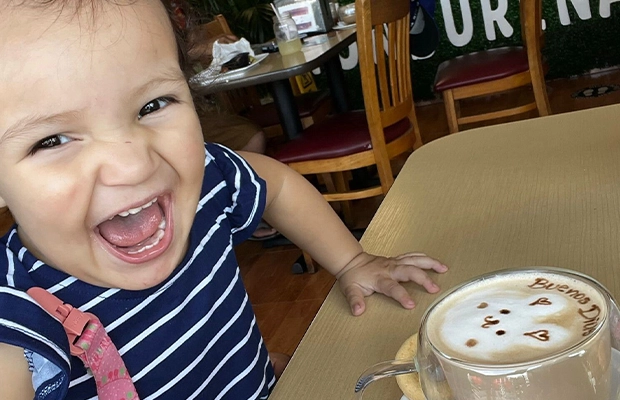
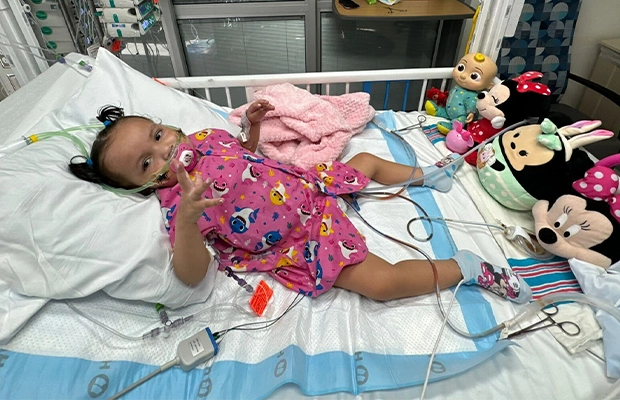
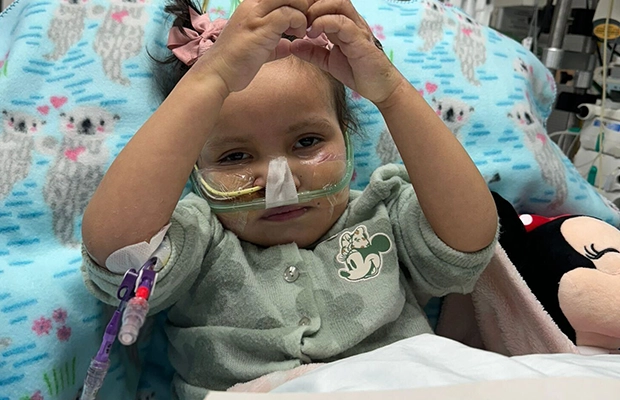
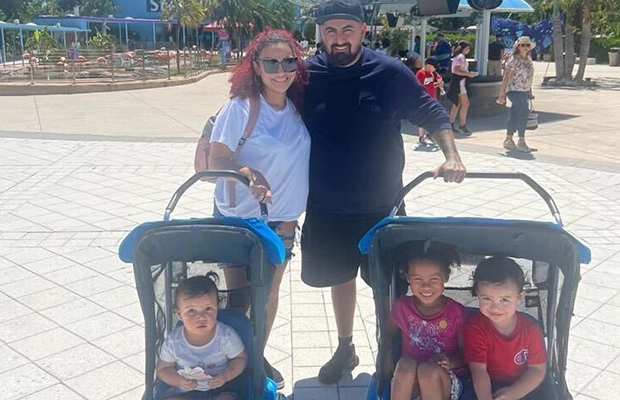
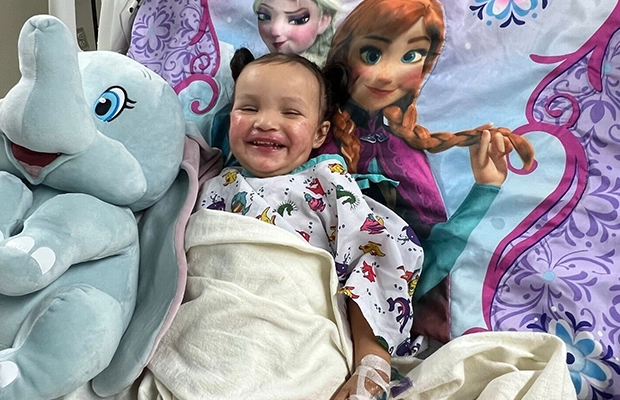
By: Miranda Torres
By the time Sheli Cataleya Gutierrez blew out the candles on her second birthday cake, she had already faced a grim diagnosis, survived two cardiac arrests, and found herself on the list for a heart transplant. The toddler’s family knew there was only place where their daughter would have a fighting chance: Holtz Children’s Hospital.Sheli was 1 when she arrived at Holtz Children’s emergency room, where she presented with acute respiratory symptoms. During the visit, the pediatric cardiac team performed an echocardiogram, which showed a severely dilated left atrium – a lack of function in one of the four chambers of the heart. In order to figure out the severity of Sheli’s condition, the family was referred to Holtz Children’s outpatient cardiac clinic.
A month later, in January of 2023, Paolo Rusconi, MD, director of pediatric heart failure and transplant at the Miami Transplant Institute, and director of the Holtz Children’s pediatric cardiac intensive care unit, performed another echocardiogram, which led him to diagnose Sheli with restrictive cardiomyopathy – a rare condition that causes the chambers of the heart to stiffen, become enlarged, and fail to relax properly, affecting its overall functionality.
During an evaluation on her second birthday, Sheli’s heart suddenly stopped beating.
“It was heartbreaking, but she was so strong,” said Sheli Galvin, her mother. “We were so scared we were going to lose her, but she overcame.”
With no medication currently in existence to treat the condition long-term, and the potential for liver and kidney failure, Sheli’s diagnosis meant a heart transplant was inevitable. Following her cardiac arrest, the pediatric cardiac care team followed her on an outpatient basis while she waited for a transplant. In January, she came down with rhinovirus and pneumonia, landing her back in the hospital. While admitted, Sheli underwent a second cardiac arrest. It took her care team more than an hour to resuscitate her, and resulted in Sheli being moved up on the heart transplant list.
Once she was resuscitated, Sheli was placed on an extracorporeal membrane oxygenator, or ECMO, which takes over the function of the heart and lungs when the organs can no longer support themselves. Rather than using standard ECMO cannulas, the team used Berlin Heart cannulas, allowing Sheli to remain mobile and alert.
For the first time in Holtz Children’s history, a pediatric patient on ECMO was able to be awake, active, and mouth-fed rather than sedated. This revolutionary technique also made Sheli a better candidate for a heart transplant since she was able to receive physical and occupational therapies, and was given less opioids and sedatives.
Her ECMO team was led by Desiree Machado, MD, director of the ECMO program at Holtz Children’s, Jennifer C. Munoz Pareja, MD, interim section chief for Holtz Children’s pediatric cardiac intensive care unit, as well as the perfusionists team.
After 40 days on ECMO, Sheli’s parents received the call that a heart donor had been found.
“We felt overwhelmed with joy and gratefulness to God for giving our daughter a second chance at life,” Galvin said.
Led by Sandeep Sainathan, MD, a UHealth Jackson Children’s Care pediatric cardiothoracic and congenital cardiac surgeon at Holtz Children’s, and Leonardo Mulinari, MD, Holtz Children’s chief of pediatric cardiac surgery, Sheli underwent her transplant, with the donor heart working immediately.
“She had all of the signs to not have a good outcome, but despite all that, she overcame,” Dr. Sainathan said. “We did a very unique ventricular assist device by using the Berlin Heart cannulas with ECMO, which is one of the reasons she was able to have high quality support, recover well, and get the transplant.”
Now, Sheli has recovered quickly and rang in her third birthday with a new lease on life.
“This little girl is meant for something very big because she’s a little warrior,” said Maylene Gonzalez, surgery coordinator for pediatric cardiac transplant at Holtz Children’s. “The fact that she tolerated ECMO for such a long time and has no lingering major effects to her health is incredible.”
After Nearly 14-Year Battle with Both Breast and Thyroid Cancer, Former Jackson Memorial Mammogram Technician Fights Lymphedema with Help from Specialized Therapy at Jackson North
After Nearly 14-Year Battle with Both Breast and Thyroid Cancer, Former Jackson Memorial Mammogram Technician Fights Lymphedema with Help from Specialized Therapy at Jackson North
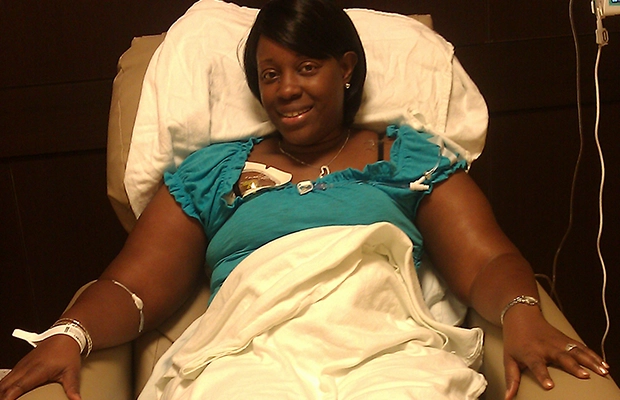
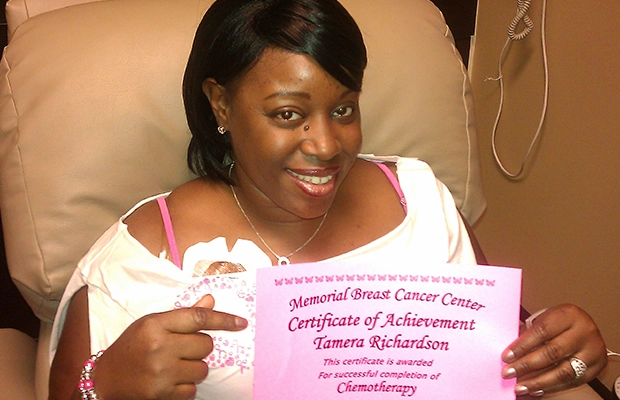
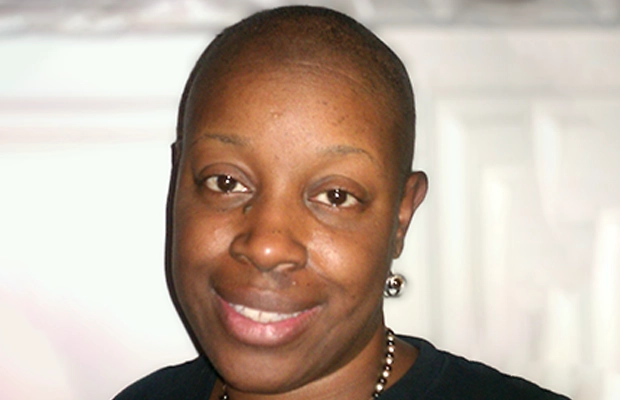
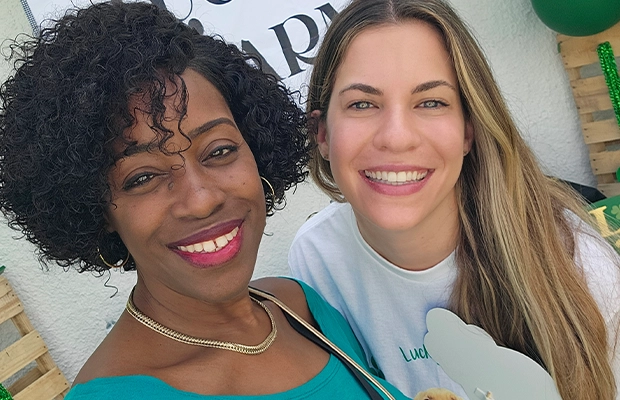
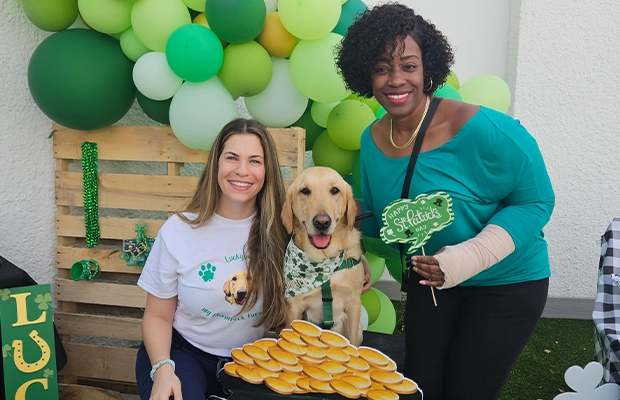
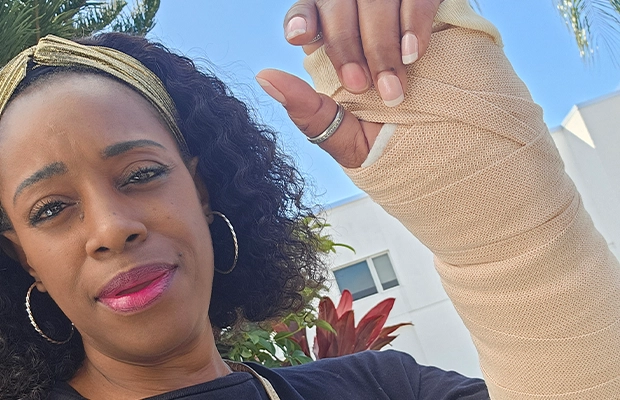
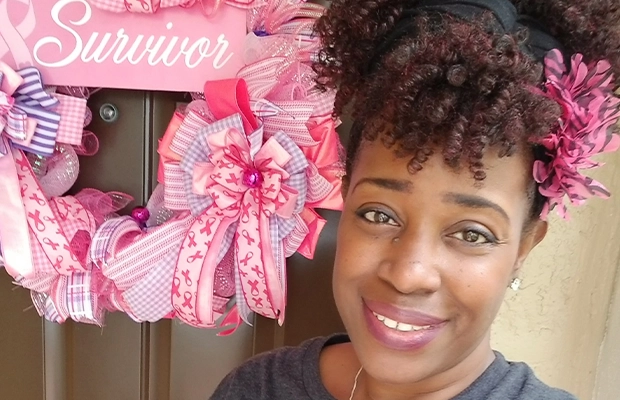
Tamera Johnson, 49, knows what it means to fight hard. As a former radiology and mammogram technician at the Roberta Orlen Chaplin Digital Breast Imaging Center/Taylor Breast Health Center at Jackson Memorial Hospital, she saw breast cancer patients and survivors every day.
“I saw everything – from women who came and passed away, to women who came back and were cancer-free,” Johnson said. “I never imagined I would become a patient, too.”
In December 2010, Johnson felt a knot in her left breast when she reached over for the television remote control at home.
“I remember that I sat up immediately in my bed and felt it,” Johnson said. “I always found it strange when patients reported knots showed up ‘out of nowhere’ – until it happened to me the same exact way.”
On December 23, 2010, a biopsy revealed that Johnson had breast cancer.
She was only 36 at the time.
For the next 10 years, she did everything she could to fight the disease, including a double mastectomy, a total hysterectomy, removal of her ovaries, and removal of her lymph nodes underneath her left arm. Additionally, she underwent chemotherapy and radiation for a year after her surgeries.
“I just knew that I wanted to fight because I didn’t want to die,” Johnson said. “The chemotherapy felt like someone was pulling every piece of energy out of your body. If I wanted to live, I had to fight with all that I had. It was a strength I never would have imagined I had.”
In January 2012, Johnson finished chemo and radiation therapies, and was cancer-free. She then underwent breast reconstruction surgery, which involved a lengthy waiting period due to skin damage from radiation therapy.
That same year, Johnson’s doctor suspected she also had thyroid cancer. Rather than take chances, she followed her oncologist’s recommendation and had a total thyroidectomy.
In 2022, after years of taking chemotherapy medication and remaining in remission, Johnson’s oncologist informed her that she was cured and again cancer-free.
“Although you never feel like yourself again, I feel blessed that I’m still here,” Johnson said.
For her entire cancer battle, she also suffered from lymphedema, a condition where fluid builds up in the body, usually in the arms or legs, causing swelling.
Over the years, Johnson received lymphedema therapy and did at-home exercises. However, the swelling became more uncomfortable, and in 2024, she was referred to Jackson North Medical Center for treatment, where she met Erica Poulin, an occupational therapist and certified lymphedema specialist.
“When Tamera came to me, her left arm was weak and felt heavy for her, making it hard for her to carry groceries and put on clothes. She was also feeling self-conscious with the way it looked,” Poulin said. “The swelling was impacting her quality of life and affecting her ability to fully participate in her roles.”
For a month, Johnson and Poulin worked on specific grip-strength exercises, and developed plans to help significantly reduce the swelling, including bandaging the arm, massages, compressions, and exercise.
“When it comes to lymphedema, we empower our patients to become independent with managing it at home. We practice exercises, compression, and massage until the swelling is reduced to fit the patient for a sleeve and maintain our results,” Poulin said. “It’s so important to know and understand what lymphedema is and how to treat it, because you’d be surprised how many patients come to us after major surgeries and have never heard of it before.”
Following lymphedema therapy at Jackson North, Johnson saw improvements in her arm’s range of motion, strength, and size. She regained the ability to wrap her arm independently, wear lymphedema sleeves comfortably, dress herself, and feel confident again.
“Tamera did so wonderful, and she was really excited about the improvements she saw – she was feeling a lot better,” Poulin said.
Today, Johnson remains cancer-free, thanks to annual visits with both her oncologist and lymphedema specialist. She focuses on managing her lymphedema and swelling, advocating for more breast cancer education in the African-American community, and maintaining a healthy lifestyle through diet and exercise.
“After so many years of battling cancer, my advice to any cancer patient is to fight – fight with all you have,” Johnson said. “Don’t give up – stay strong, and surround yourself with family and friends – don’t worry about anything else, because you will get through it.”
Jackson Saves Local Businessman and Entrepreneur, Paul Flanigan
Jackson Saves Local Businessman and Entrepreneur, Paul Flanigan
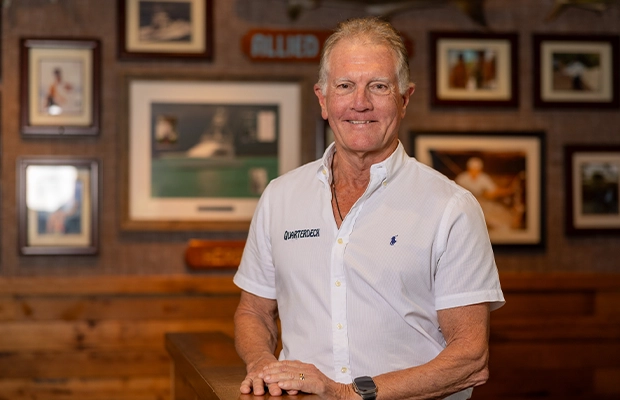
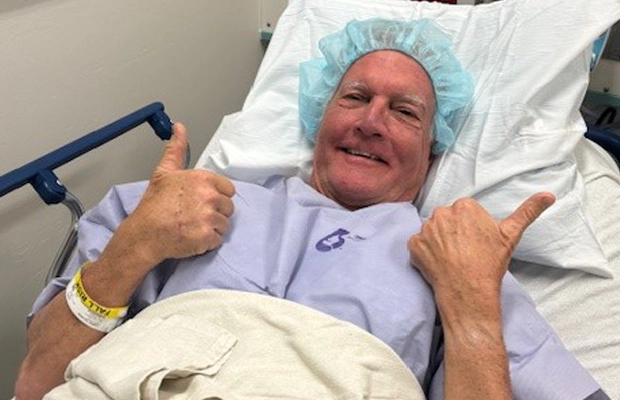
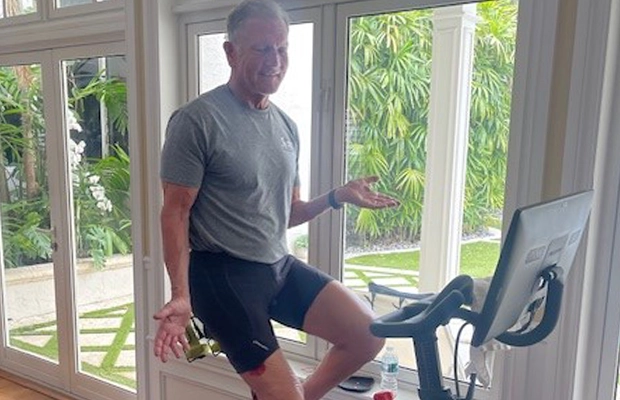
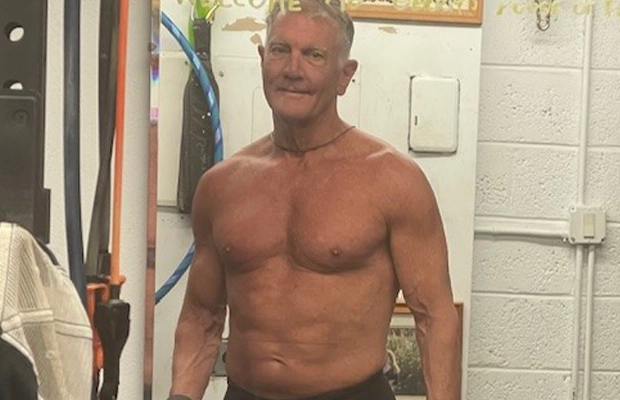
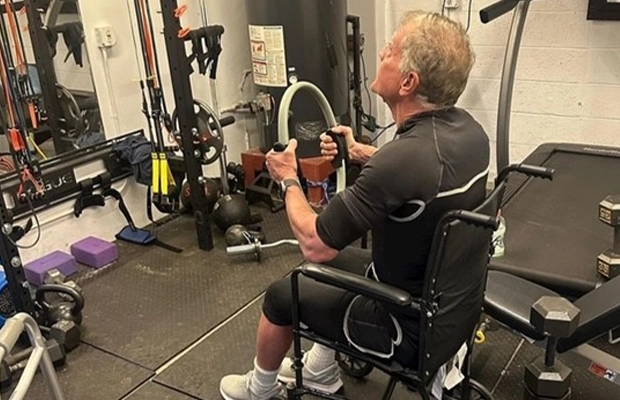
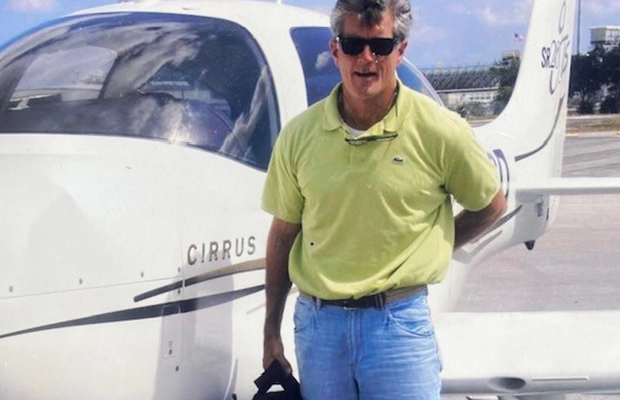
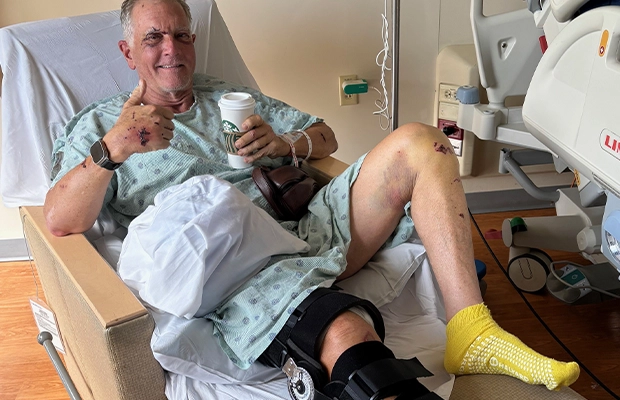
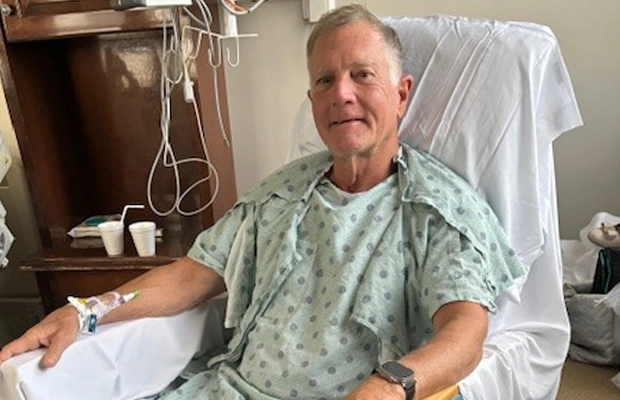
By: Miranda Torres
Paul Flanigan, 67, experienced a life-altering event when the plane he was piloting crashed on a golf course in Key Largo on March 1, 2024. He was airlifted to Ryder Trauma Center at Jackson South, which was just the beginning of his journey with Jackson Health System.
Flanigan, a well-respected local entrepreneur, has long been intertwined with the community, including a successful decade-long partnership with Flanigan’s Enterprises Inc., where he managed several of the beloved Flanigan’s Seafood Bar and Grill franchises. Later, he purchased Quarterdeck from Flanigan’s Enterprises, and established multiple locations across Florida.
Flanigan arrived at Ryder Trauma with severe fractures to his hip and knee area. He was cared for by Joyce Kaufman, MD, a critical care surgeon, and Marilyn Heng, MD, an orthopedic trauma surgeon. Dr. Heng operated on his hip. Two days later, Flanigan underwent surgery to address the fracture around his knee.
The plane crash came just four years after a bicycle accident caused Flanigan to break part of his pelvis, which triggered severe arthritis. The injuries he sustained during the plane crash caused his arthritis to accelerate, leaving him with discomfort and a limited range of motion. Flanigan eventually had a total hip replacement with Dr. Heng.
“Every step of the way during my time at Jackson, it seemed like there was help there instantaneously,” he said. “My previous crash meant I sort of knew what to expect, but I was grateful for how knowledgeable and friendly they were, especially since I didn’t know how long I would be there. I was blessed.”
Since his hip replacement, Flanigan has been receiving physical therapy to help him regain his total range of motion. He was non-weight bearing for the first 10 weeks of his rehabilitation, but is now getting back to the activities he loves most, like playing pickleball, chasing after his grandchildren, and dancing with his wife, Michelle.
“For his age, he’s fantastically active and very kind in terms of always being polite and good natured. His love of activity and function is of a much younger person,” Dr. Heng said.
While Flanigan’s recovery is well underway, another challenge awaits: a knee replacement surgery with Victor Hernandez, MD, an orthopedic surgeon with UHealth – University of Miami Health System. Flanigan remains optimistic and is eager to regain full mobility so he can focus on what matters most to him—his family.
“I could never thank the team at Jackson enough,” Flanigan said. “If I could, I’d share the blessings I receive at the conclusion of every mass: ‘May the almighty God bless you and keep you safe to love and serve others.’”
St. Croix couple involved in hit and run recovers with help from Ryder Trauma Center and Lynn Rehabilitation Center
St. Croix couple involved in hit and run recovers with help from Ryder Trauma Center and Lynn Rehabilitation Center
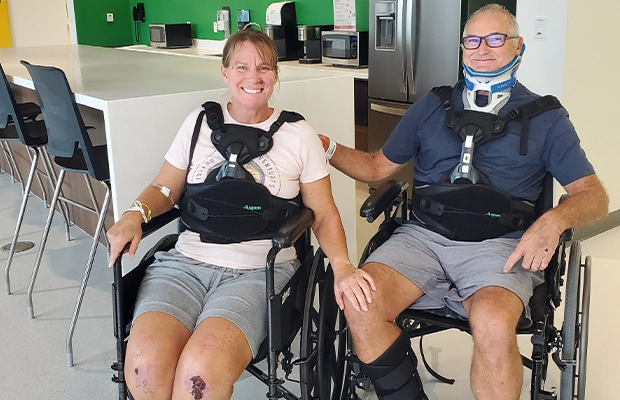

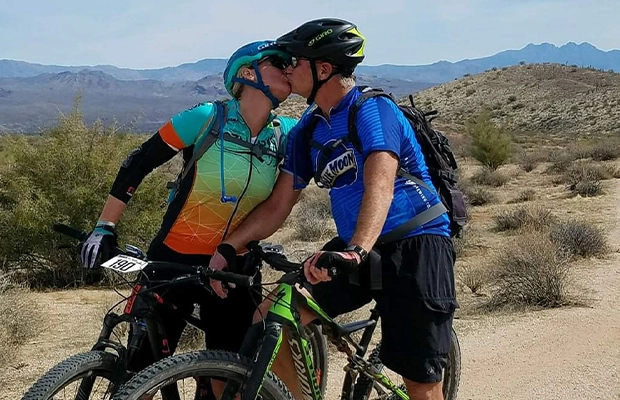

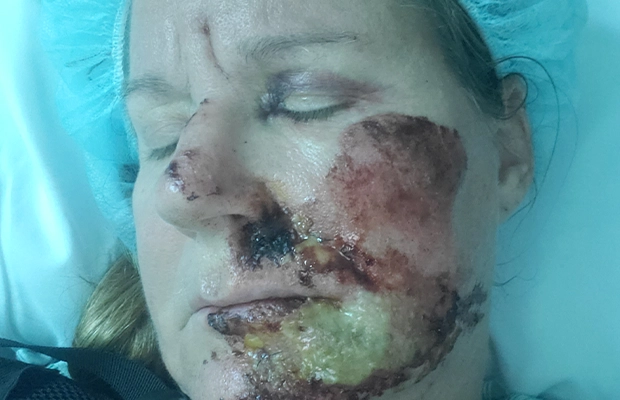
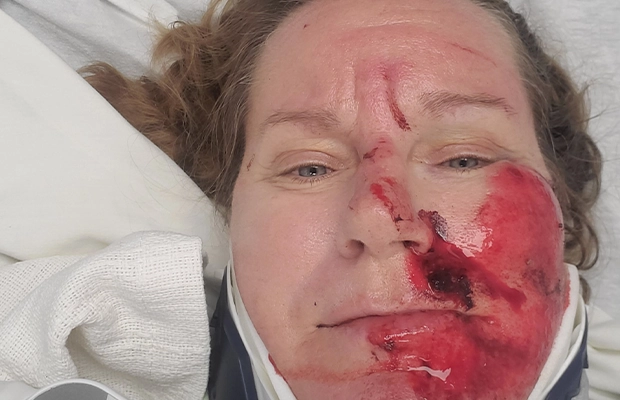

By: Krysten Brenlla
Kevin Stalbaum, 63, and his wife, Amy Stalbaum, 53, live for adventure. After Kevin worked for the U.S. Air Force and Arizona’s Power and Water Company for years, the couple decided a quiet retirement awaited them in the Caribbean island of St. Croix.
“The scuba diving in St. Croix is amazing. We’re renovating our hurricane-damaged dream house on the island ourselves, and there is a great cycling community there,” Amy said. “Cycling is one of our favorite things to do together.”
They never thought the activity they loved the most would almost cost them their lives.
On September 17, the Stalbaums began their bike ride at 6:45 a.m. Less than 10 minutes into their ride, a car crashed into both of them from behind.
“We’re both experienced cyclists, and we do everything we can to be as visible and as safe as possible,” Amy said. “Despite our precautions, we were hit, and we don’t know why. The driver and the car are still missing.”
The impact from the crash left both Amy and Kevin unconscious on the road. Emergency medical services arrived to the scene and rushed the couple to the nearest emergency room on the island, where doctors diagnosed Kevin with leg, cervical, and lumbar fractures, and Amy with severe road rash, a brain bleed, and a spinal fracture.
“At one point, I remember being on a gurney, with Amy on her gurney next to me,” Kevin said. “I remember asking, ‘what’s going on?’ And that’s the last thing I remember before waking up in Miami.”
Because of the severity of their injuries, Amy and Kevin needed to be medically evacuated to the nearest trauma center, and by Monday, September 18, the Stalbaums arrived to Ryder Trauma Center at Jackson Memorial by helicopter, where they were prepped for emergency surgery.
“The first thing we had to do with Kevin was make sure he was stabilized from a cardio pulmonary standpoint,” said Stephen Shelby Burks, Jr., MD, a UHealth – University of Miami Health System neurosurgeon and spinal cord surgeon at Jackson. “He needed a collar due to his cervical fracture, and a custom lumbar brace. For Kevin’s lumbar surgery, we used a CT-based navigation surgical system, which enabled us to direct the screws in the exact position needed. With this procedure, we hope to mitigate Kevin’s pain, and avoid any deformities in his spine from forming in the future.”
At the same time, Amy was also undergoing spinal surgery.
“The ligaments of Amy’s spine were ripped apart,” said Evan J. Trapana, MD, a UHealth orthopedic spine surgeon at Jackson. “Amy is very young and active, which is why we went the route we did by placing rods and screws in her spine to stiffen the spine’s structure, giving her a stable construct for her body to weigh on. In six months, when everything is healed up, we’ll remove the rods and screws to preserve most of her motion and lower the risk of her needing future spinal surgery.”
Amy’s surgical team used robot-assisted surgery to place the screws and rods in her spine; Jackson Memorial is one of a few hospitals in the nation with the robot technology available for use in spinal surgery.
“It really helps us, as surgeons, safely implement screws with pinpoint accuracy,” Dr. Trapana said. “It also shaves time in the operation, and provides a better recovery rate for patients.”
After spending nearly three weeks in the hospital, the Stalbaums were discharged on October 10. They received rehabilitation therapy at Christine E. Lynn Rehabilitation Center for The Miami Project to Cure Paralysis at UHealth/Jackson Memorial, and created comprehensive plans with therapists to help with their mobility, balance, endurance, and strength.
With the help of physical, occupational, and cognitive therapies, the couple look forward to making a full recovery, so they can return to St. Croix.
They’re grateful to the teams at Ryder Trauma and Jackson Memorial for not only saving their lives, but giving them the chance to keep their adventures going for years to come.
“We count our blessings that we landed here,” Amy said. “Jackson’s staff and our community back home in St. Croix really helped us get through this.”
Faith, Family, and Revolutionary Teamwork Save Noah Langlois’ Life at Holtz Children’s Hospital
Faith, Family, and Revolutionary Teamwork Save Noah Langlois’ Life at Holtz Children’s Hospital
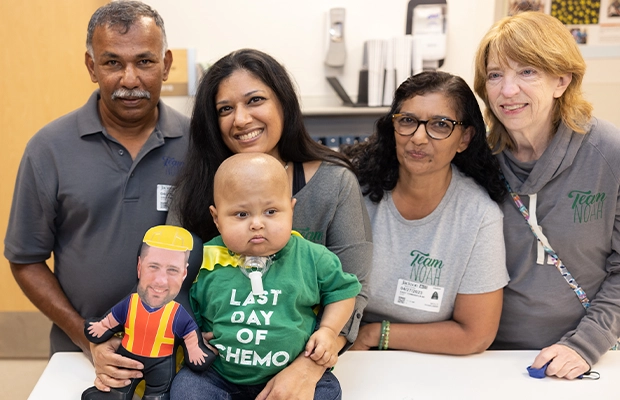
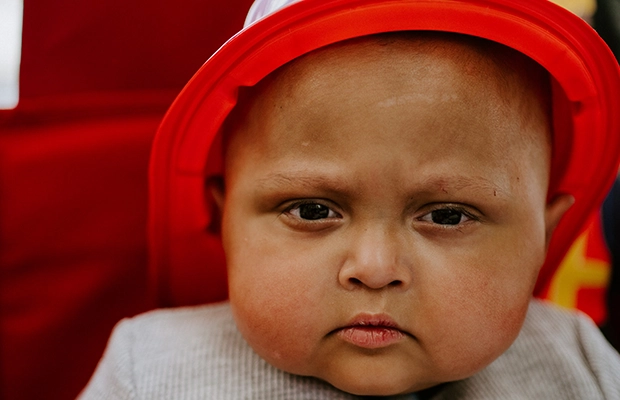
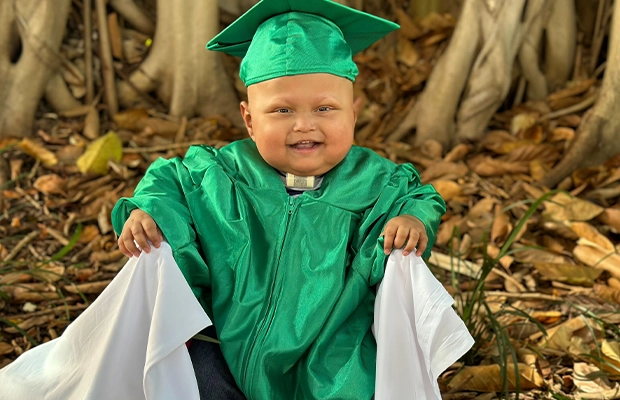
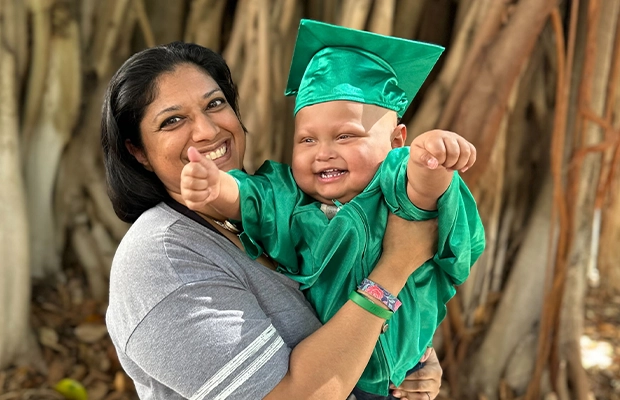
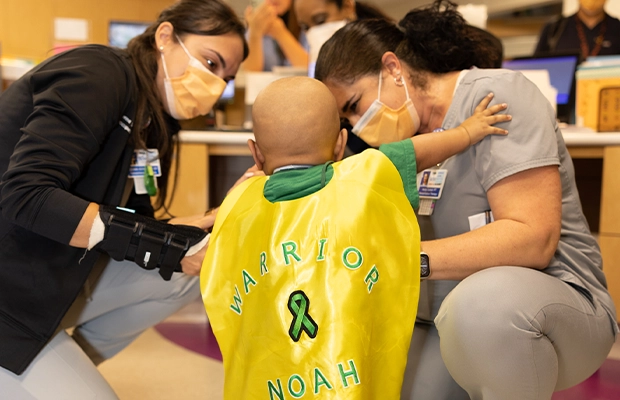
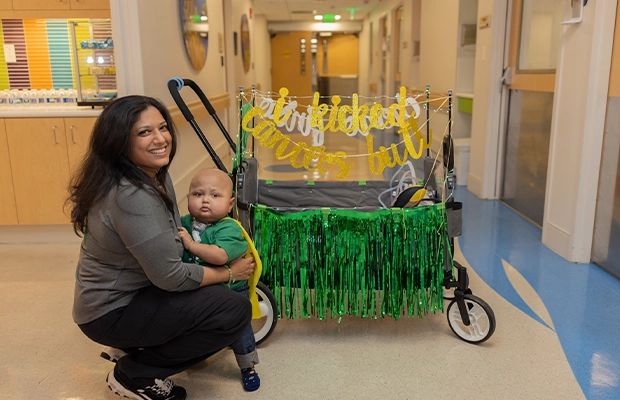
By: Miranda Torres
When Michelle Ramkumar Langlois welcomed her first child, Bruce Noah Langlois, on November 29, 2020, she never could have predicted what the next few years of their lives would look like. Noah, born prematurely at 25 weeks and hardly weighing more than a pound, spent his first 207 days of life in a neonatal intensive care unit in Ft. Myers.
Almost seven months later, Noah was finally discharged, but the celebrations were short-lived. Four days later, Noah’s father, Bruce Langlois, unexpectedly passed away.
“His dad was an amazing guy and I think Noah gets a lot of his spirit from him,” Langlois said. “His dad was very outgoing and extroverted and Noah is that in spades. I think he gets his sweetness and his kindness from his dad for sure.”
Despite the heartbreak Noah’s family was experiencing, Langlois was determined to give her son the best life possible.
On his first birthday, she found a strange lump on his stomach. One week later, it was determined that the lump was a tumor that occupied 90 percent of his liver – also known as a pretext 3 hepatoblastoma since it was in three zones of his liver.
“When we got the diagnosis of hepatoblastoma, I was just so concerned for his future,” Langlois said. “I was thinking, ‘What is my little guy going to go through?’”
Noah’s oncologists told Langlois that his treatment options included chemotherapy with the hopes of shrinking the tumor, and eventually a liver transplant or resection. After four rounds of chemotherapy in Ft. Myers, Noah’s tumor did not shrink.
His care team contacted Jennifer Garcia, MD, medical director of pediatric transplant services, adult and pediatric intestinal rehabilitation, and intestinal transplant at the Miami Transplant Institute (MTI), an affiliation between Jackson Health System and UHealth – University of Miami Health System.
Dr. Garcia meet with Noah and his doctors via telehealth one month after his diagnosis. They decided Noah should be transferred to Holtz Children’s Hospital at University of Miami/Jackson Memorial Medical Center on March 24, 2022.
The night before his scheduled transfer, Noah went into cardio-pulmonary arrest. While he was quickly resuscitated and intubated, the Ft. Myers team didn’t think Noah would survive the transfer. Thankfully, Juan Pablo Solano, MD, a pediatric critical care specialist at Holtz Children’s, was the attending physician in the pediatric intensive care unit at the time and approved his transfer.
On March 29, 2022, Noah was airlifted to Holtz Children’s. Upon arrival, he was battling respiratory failure due to a sepsis infection and effects of his recent cardio-pulmonary arrest. His tumor was pressing against his diaphragm, making it difficult for him to breathe and eat. He mainly survived on parenteral nutrition (TPN) for a year.
He spent six months in the pediatric intensive care unit undergoing more rounds of chemotherapy. Noah’s mom and grandmother moved into the Ronald McDonald House, which is conveniently located on the Jackson Memorial campus, allowing them to spend their days alongside him.
“Noah and God gave me the strength to keep going every day,” Langlois said. “It’s hard to stay in a state of sadness and despair when this little guy is saying, ‘I’m not giving up, I’m still here, and I’m still fighting.’”
Noah’s care team reached out to Prasoon Mohan, MD, a UHealth interventional radiologist, who researched whether forms of a Y-90 embolization could be safely performed on a patient of Noah’s age and size.
A Y-90 embolization is a minimally invasive procedure that combines embolization and radiation therapy to treat liver cancer. Dr. Moha’s research found that this procedure had never been performed on such a young patient.
Noah’s family and the rest of the medical team decided to move forward with the experimental treatment. The results showed the liver was indeed responding. Dr. Mohan then treated Noah with two rounds of bland embolization, and the tumor significantly reduced in size, making him eligible for transplant.
“I want to stress that this kind of success can only happen at a place like Jackson, and that is because of the wide-range of expertise that we have here,” Dr. Mohan said. “The expertise of the different specialists and the trust we have in each other allows us to work as a team. We really do make miracles happen here.”
“You pray for months and months for these things to fall in place, but it’s a hard thing to pray for because you know what it means for someone else,” Langlois said. “I prayed that no matter how it happened that God would provide a way for Noah to have a long, healthy, beautiful life.”
On December 29, 2022, Langlois received the call that would forever change their lives – a donor had been found for Noah.
“He has come out of so many very difficult situations before his transplant, which showed us he would be able to overcome a transplant surgery,” said Akin Tekin, MD, liver, intestinal, and multivisceral surgeon at MTI.
Vighnesh Venkatasmy, MD, transplant surgeon at MTI, travelled out of state to procure the donor liver. Gennaro Selvaggi, MD, transplant surgeon at MTI, cut down the liver to fit Noah’s small frame. .Dr. Tekin then performed the transplantation of the new liver into the young boy.
While Noah was undergoing his transplant, his family rallied together in prayer. “Noah is a fighter; he was born fighting and he hasn’t stopped yet. He is an inspiration not only to us, but to so many people that have come to know him,” said Molly and Albert Ramkumar, Noah’s maternal grandparents.
Post-transplant, Noah underwent his two final rounds of chemotherapy. In April, he officially rang the bell on the oncology floor of Holtz Children’s, signifying the end of his cancer treatment, and marking the eminent end of his chapter as an inpatient.
“The past two years have been a rollercoaster, but I would not have missed this time with Noah and Michelle for anything,” said Stacy Langlois, Noah’s paternal grandmother. “We have been a part of every procedure, surgery, chemo treatment, infection, sleepless night, devastating news; but also a part of his smiles, love, his effect on everyone he meets, and his love for life.”
A year and three months later, Noah and his family are preparing for discharge. Before he heads home, he is undergoing physical, speech, and occupational therapies.
“This child has such a desire to live and play and be social from such a young age that he motivates everyone around him to do more and help him improve,” said Heidy Carbot, a pediatric physical therapist at Holtz Children’s.
The family plans to split his follow-up care between Holtz Children’s and a local hospital closer to their home in Ft. Myers.
“When we got here a year ago, we didn’t know if we would be leaving Holtz Children’s with Noah, ever. Chances were so high we that he was not going to survive this,” Langlois said. “But here we are at the end of this journey, and it is because of the team here at Holtz Children’s who never gave up on him and the care he has received. ‘Thank you’ is not adequate, but it is all I’ve got.”
Defying the Odds: Danielle’s Miraculous Recovery at Ryder Trauma Center
Defying the Odds: Danielle’s Miraculous Recovery at Ryder Trauma Center
In September 2013, Danielle Press suffered life-threatening injuries in a boating accident off the coast of Key Biscayne – the very place where her father is police chief.
Danielle, 26 at the time, was rushed to Ryder Trauma Center with several deep, lacerating injuries to her upper leg. Trauma surgeons immediately operated on Danielle, who had lost a lot of blood and nearly died.
The medical team at Ryder Trauma, led by UHealth – University of Miami Health System trauma surgeon Gabriel Ruiz, MD, and UHealth orthopaedic trauma surgeon Fernando Vilella, MD, saved Danielle’s life.
The sciatic nerve in Danielle’s left leg, which controls the majority of movement and sensation in the leg, had been completely cut and separated. Danielle, an active college graduate who had traveled extensively in Asia teaching English, was told she may lose her leg and never gain feeling or movement again in her leg because repairing the sciatic nerve – the largest nerve in the human body – is one of the most challenging nerve surgeries.
But Allan Levi, MD, a UHealth neurosurgeon at Jackson Memorial Hospital, obtained approval from the FDA to perform a unique procedure on Danielle, combining standard nerve grafting with her own Schwann cells, in hopes of regenerating the nerve and restoring her function. Dr. Levi also led the world’s first Phase 1 of FDA approved clinical trial, through The Miami Project to Cure Paralysis, using a patient’s own Schwann cells to treat paralysis, so he felt this would give Danielle the best chance at some level of recovery.
The world’s first procedure, performed in October 2013 at Jackson Memorial Hospital, was a success – and the progress Danielle has made since then has been remarkable.
In the nearly four years since the near fatal accident, Danielle moved to Taiwan, where she climbed one of the highest mountains and volunteered to carry water jugs to temples. She visited one of the world’s largest caves in Borneo, swam in turquoise lagoons in the Philippines, camped all over Japan, became certified as an advanced diver, and dove with a school of hammerhead sharks. She has become a writer, and her writings about the accident, her recovery, her passion for fitness, and travel have been published on several websites.
Danielle recently married her longtime boyfriend, Jeff. The couple is living in the Jamaican countryside, working and learning on a vegetable farm. Their next adventure will bring them back to North America, where they plan on following their dreams of opening a “Farm to Table” bed and breakfast lodge.
All this, she says, would not have been possible without the second chance she was given at Ryder Trauma.
“My gratitude for the staff, the doctors, the nurses, and the specialists knows no bounds,” Danielle said. “They played such a paramount role in my recovery and I will never forget them.”
This Doctor’s Day, we share a story of compassion and friendship that reminds us of how fragile life can be, and how grateful we all are to have doctors that care about helping others.
This Doctor’s Day, we share a story of compassion and friendship that reminds us of how fragile life can be, and how grateful we all are to have doctors that care about helping others.
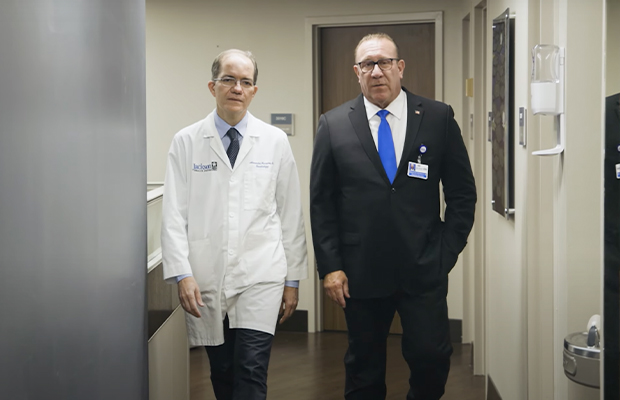
By: Krysten Brenlla
Romualdo Segurola, MD, 58, is no stranger to heart health. A practicing cardiovascular surgeon for 20 years, Dr. Segurola has seen patients from around the world with extensive heart disease, and has dedicated his life to helping them.
That’s why when Dr. Segurola, Jackson Health System’s chief of cardiac surgery and medical director of Jackson Heart Institute, felt intense chest pain on the night of January 22, 2022, he knew what he was feeling.
“For some time, I was feeling discomfort – my brother had just passed away, and my health was suffering as I grieved his passing,” Dr. Segurola said. “Months before, I was checking my heart health frequently, but that night, I started feeling chest discomfort, and in a very short period of time, that chest discomfort went south. It was the worst pain I’ve ever felt in my life.”
From his home, Dr. Segurola immediately called Alexandre Ferreira, MD, chief of cardiology for Jackson Heart Institute, to let him know his symptoms.
As soon as he received the call, Dr. Ferreira rushed to Jackson Memorial Hospital to care for his colleague and friend.
“It is a strange emotion when you see one of your close colleagues experiencing severe pain,” Dr. Ferreira said. “Dr. Segurola’s case was different than any other patient I’ve treated because when he called me, he already had a diagnosis for himself. He said, ‘my friend, I’m having a heart attack.’”
When he arrived at Jackson Memorial, Dr. Segurola was rushed to the catheterization laboratory for life-saving treatment. Upon evaluation, Dr. Ferreira and his team found that Dr. Segurola suffered a “widowmaker” heart attack, a type of heart attack that involves an obstruction of the left anterior descending artery, one of the most important arteries that provides blood to the heart.
“When all this was happening, the fact that these are my friends and colleagues didn’t matter to me,” Dr. Segurola said. “At that moment, I was just seeing my doctors, and I put all my trust in them to save my life.”
Dr. Ferreira and his team performed a coronary angiography to identify where the obstruction occurred. Through a blood vessel in the groin area, they advanced a catheter to the level of the heart, and placed a balloon at the site of the lesion.
“Through the catheter, we were able to place a balloon and inflate it, which stretched the vessel open and allowed us to insert a stent, or a metal tube, to prevent the vessel from collapsing again,” Dr. Ferreira explained. “The procedure restores blood flow to the heart muscle, and most patients experience immediate resolution of chest pain.”
After less than an hour, Dr. Segurola’s chest pain was almost completely gone. He spent two days in the intensive care unit before being discharged.
One year later, Dr. Segurola feels healthier and stronger than ever. He exercises regularly, and follows a strict regimen with medication and a healthy diet.
“The fact that we are able to see him every day, ask him how he’s doing, have him continue to provide patient care, and know that he’s doing well – it’s a great joy,” Dr. Ferreira said.
Dr. Segurola continues to do what he loves by helping patients maintain their heart health, and saving their lives from deadly diseases that may lead to a heart attack – an experience he knows all too well.
“Going through something like this, you really understand your patients better, and that’s priceless,” Dr. Segurola said. “I knew that whatever I would have to face, we would have been able to take care of it here, at Jackson, because this is the only true comprehensive program in South Florida.”
“I can’t thank my friends and colleagues at Jackson enough for saving my life.”
Local Firefighter Receives Kidney Donation from Sister at Miami Transplant Institute
Local Firefighter Receives Kidney Donation from Sister at Miami Transplant Institute
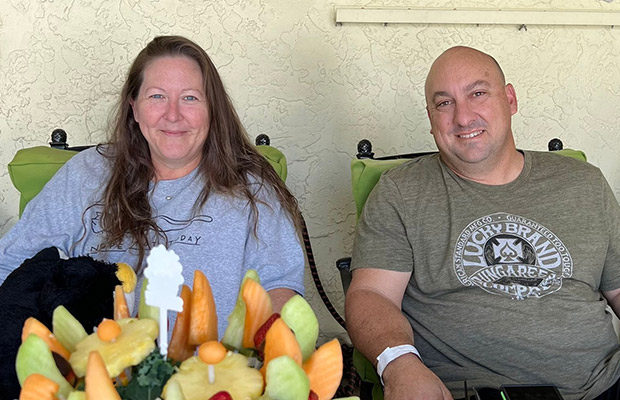
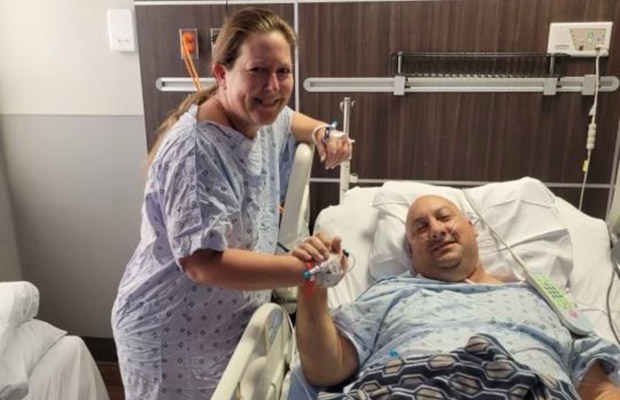
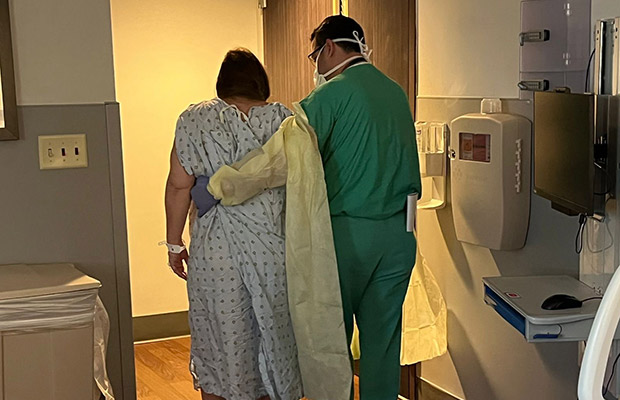
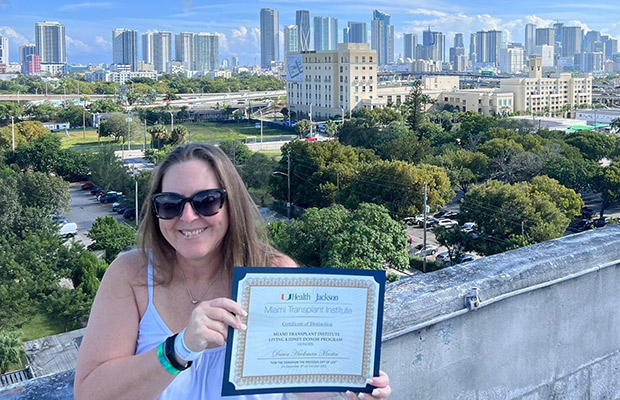
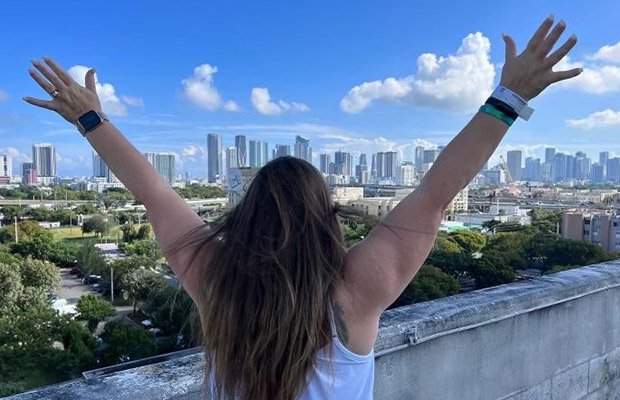
Jeffrey Hackman, a firefighter with the Miami-Dade Fire Rescue Aviation Division, was used to jumping in front of danger to save lives.
However, in 2015, he found his life in danger when his doctor discovered traces of blood in his urine during a routine physical.
For the next six years, Hackman, 47, saw a nephrologist annually, who tested him for kidney damage.
“I’ve had some blood in my urine on and off since my teens, but never thought anything of it,” Hackman said. “I felt fine and had no symptoms of anything else being wrong, but we still monitored it every year like clockwork.”
It wasn’t until September 2021, during an annual checkup with the fire department, that his doctor found something concerning.
Hackman’s kidney function dropped from 30 percent to 17 percent, and he became a critical case.
“The hardest thing for me was when I was pulled off of my fire truck to regular duty in the fire department,” Hackman added.
“I wanted to pretend nothing was wrong, but no longer having my truck after 27 years was when I finally realized things were serious.”
By October 2021, Hackman was experiencing leg swelling from his knees down to his feet and ankles, a symptom of chronic kidney disease.
It became clear he needed a kidney transplant.
After several inquiries across the U.S., Hackman found the perfect place to prepare for the procedure, and it was right in his backyard– the Miami Transplant Institute (MTI), an affiliation between Jackson Health System and UHealth – University of Miami Health System.
All he needed was a donor.
“I was still in denial, thinking I’d get better on my own,” Hackman said. “I had tough-guy syndrome, and thought everything would be fine, when in reality, it wasn’t.”
Finally accepting his condition, Hackman took to social media to find a solution. He posted his story, and soon, support came flooding in.
Within a few days, his ideal match came from his own family – his big sister, Dawn Martin, who lives in Atlanta.
“I’ve always looked up to my brother, and now he needed my help,” Martin said. “I called him and said, ‘Are you busy December 8?’ and he said no, and I said, ‘Good, because you’re getting my kidney!’”
Martin and Hackman’s loved ones and friends were part of their journey for the next three weeks, providing them with a place to stay, daily meals, and the resources they needed to face this life-changing event.
On the day of the transplant surgery, the siblings were prepped and transferred to two separate operating rooms – one for the donor and one for the recipient.
Rodrigo Vianna, MD, PhD, director of Transplant Services, and chief of liver, intestinal, and multivisceral transplant at MTI, removed Martin’s kidney using robotic surgery.
“The biggest difference in using robotic surgery is the pain level during the patients’ recovery,” Dr. Vianna explained. “Most of the living donors return home within 24 hours –that’s a huge benefit.”
In the other operating room, the MTI surgical team was confident that a living kidney donor was the best way to save Hackman.
After a successful recovery, Martin was discharged the day after surgery, well enough to continue recovering at home. Just weeks after her first follow-up appointment, she and her husband were ready to drive back to Atlanta to reunite with their children.
Hackman was discharged after three days in the hospital. His wife, Aly, and his parents took over his care and recovery.
Martin now sees her health in a new perspective – she’s adding more exercise to her daily routine and is eating healthier.
When she looks at her new tattoo of the Miami-Dade County Fire Rescue emblem on her forearm, she is reminded of her brother, and how sometimes, even heroes need help.
“It’s a tribute to my brother, but it also gives me a chance to talk about the donor program at MTI and how important it is,” Martin said.
After a few weeks, Hackman settled back into his routine, and has returned to saving other people’s lives with a healthy kidney in place.
“I believe my diligence in listening and trusting the surgeons and caretakers at Jackson sped up my recovery,” he said. “I feel fortunate to have such an incredible team of healthcare professionals close to home.”
St. Croix Doctor Who Suffers Heart Attack Is Airlifted to Miami for a Lifesaving Surgery by Jackson Cardiac Team
St. Croix Doctor Who Suffers Heart Attack Is Airlifted to Miami for a Lifesaving Surgery by Jackson Cardiac Team
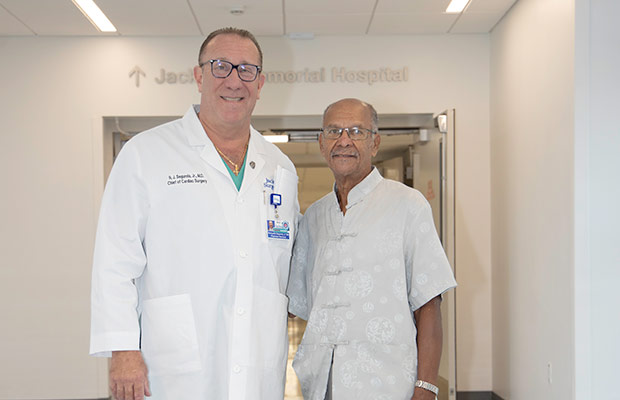
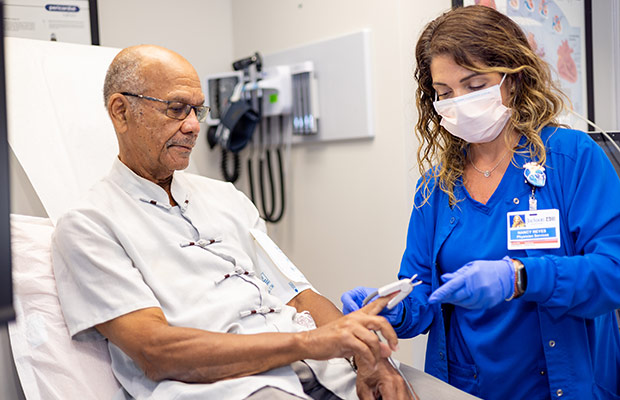
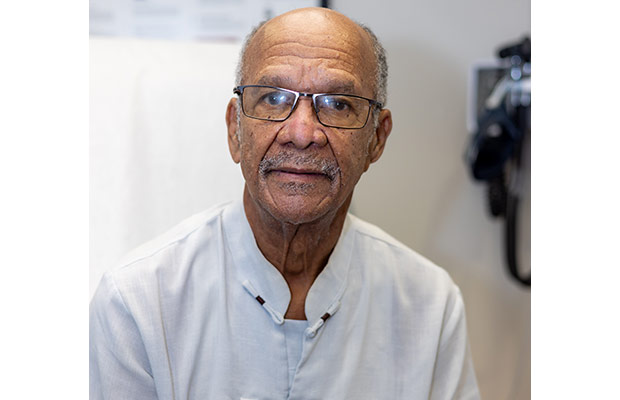
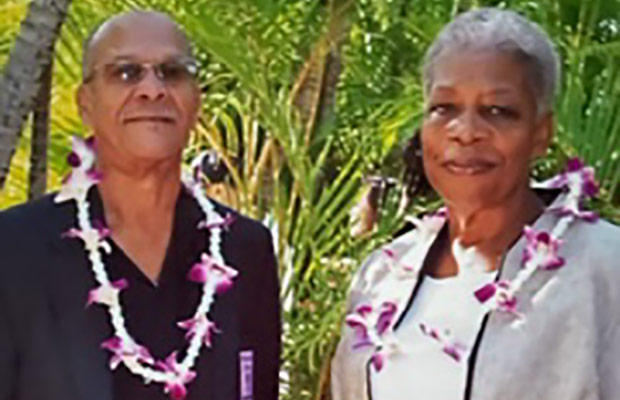
Lloyd Henry, MD, has spent decades saving lives as a general surgeon at Governor Juan F. Luis Hospital in St. Croix, U.S. Virgin Islands. At age 84, he had lived a healthy life with no prior medical concerns. However, that changed on November 16, 2021.
While assisting in an open gallbladder removal surgery, Dr. Henry suddenly began to experience fainting episodes. Fainting, also known as syncopal episodes, results from a sudden drop in heart rate and blood pressure. It is often due to strain, stress, or long periods of standing, all of which Dr. Henry experienced.
“We were finishing up and I just felt strange,” he recalled. “I looked at the other surgeon and told him that I felt funny.”
The next thing Dr. Henry remembers was waking up in the operating room with severe right lower back pain, numbness, and difficulty moving his right foot. Upon evaluation, the medical team revealed the situation was much more serious. He would need medical attention at a facility with the expertise and resources to give him the best care.
The next day, Dr. Henry was airlifted to Jackson Memorial Hospital.
Jackson Memorial’s cardiothoracic medical team immediately performed an echocardiogram and a computed tomography angiography (CTA) of his chest and abdomen that revealed a tear in his aorta, also known as the coronary artery – the artery that delivers oxygenated blood from the heart to the rest of the body. According to the National Library of Medicine, less than 50 percent of patients with a ruptured aorta survive. Exams also revealed that there were signs of mild-to-moderate aortic valve regurgitation, which is a condition that occurs when the heart’s aortic valve does not close tightly.
The team called in the expertise of Romualdo Segurola, MD, Jackson Health System’s chief of cardiac surgery and director of the Jackson Heart Institute.
“The most impressive thing about Jackson to me is that it’s the only true comprehensive health system in South Florida. Our advanced technology also sets us apart,” Dr. Segurola said. “The teams that treated Dr. Henry involved cardiothoracic surgery, cardiology, and critical care. Together, they were able to see to all his needs in a timely and effective way.”
Dr. Segurola performed multiple surgeries on Dr. Henry, including an emergency ascending aortic dissection repair, aortic valve replacement, and an exclusion amputation of the left atrial appendage that helps prevent strokes by sealing off a small section of the heart called the left atrial appendage. This is a site where blood clots may form during an arrhythmic episode.
All the procedures were successful. Dr. Henry was able to return home to St. Croix within two weeks and was back at work two months later. Today, in addition to his work at the hospital in St. Croix, he takes pride in his gardening, time with his wife, and seeing his seven grandchildren and five great-grandchildren grow up.
“Jackson is like the major leagues. The staff is excellent from beginning to end,” Dr. Henry said. “I owe my healthy track record to my faith, taking care of myself, and giving back to my community, but I thank the top medical care I was able to access that has given me my life back.”
Baby Born with Congenital Heart Disease Receives Treatment at Holtz Children’s Hospital
Baby Born with Congenital Heart Disease Receives Treatment at Holtz Children’s Hospital




Lloyd Henry, MD, has spent decades saving lives as a general surgeon at Governor Juan F. Luis Hospital in St. Croix, U.S. Virgin Islands. At age 84, he had lived a healthy life with no prior medical concerns. However, that changed on November 16, 2021.
While assisting in an open gallbladder removal surgery, Dr. Henry suddenly began to experience fainting episodes. Fainting, also known as syncopal episodes, results from a sudden drop in heart rate and blood pressure. It is often due to strain, stress, or long periods of standing, all of which Dr. Henry experienced.
“We were finishing up and I just felt strange,” he recalled. “I looked at the other surgeon and told him that I felt funny.”
The next thing Dr. Henry remembers was waking up in the operating room with severe right lower back pain, numbness, and difficulty moving his right foot. Upon evaluation, the medical team revealed the situation was much more serious. He would need medical attention at a facility with the expertise and resources to give him the best care.
The next day, Dr. Henry was airlifted to Jackson Memorial Hospital.
Jackson Memorial’s cardiothoracic medical team immediately performed an echocardiogram and a computed tomography angiography (CTA) of his chest and abdomen that revealed a tear in his aorta, also known as the coronary artery – the artery that delivers oxygenated blood from the heart to the rest of the body. According to the National Library of Medicine, less than 50 percent of patients with a ruptured aorta survive. Exams also revealed that there were signs of mild-to-moderate aortic valve regurgitation, which is a condition that occurs when the heart’s aortic valve does not close tightly.
The team called in the expertise of Romualdo Segurola, MD, Jackson Health System’s chief of cardiac surgery and director of the Jackson Heart Institute.
“The most impressive thing about Jackson to me is that it’s the only true comprehensive health system in South Florida. Our advanced technology also sets us apart,” Dr. Segurola said. “The teams that treated Dr. Henry involved cardiothoracic surgery, cardiology, and critical care. Together, they were able to see to all his needs in a timely and effective way.”
Dr. Segurola performed multiple surgeries on Dr. Henry, including an emergency ascending aortic dissection repair, aortic valve replacement, and an exclusion amputation of the left atrial appendage that helps prevent strokes by sealing off a small section of the heart called the left atrial appendage. This is a site where blood clots may form during an arrhythmic episode.
All the procedures were successful. Dr. Henry was able to return home to St. Croix within two weeks and was back at work two months later. Today, in addition to his work at the hospital in St. Croix, he takes pride in his gardening, time with his wife, and seeing his seven grandchildren and five great-grandchildren grow up.
“Jackson is like the major leagues. The staff is excellent from beginning to end,” Dr. Henry said. “I owe my healthy track record to my faith, taking care of myself, and giving back to my community, but I thank the top medical care I was able to access that has given me my life back.”
